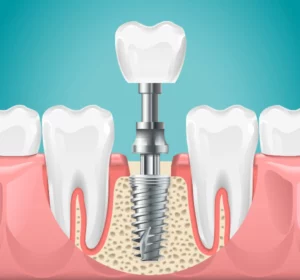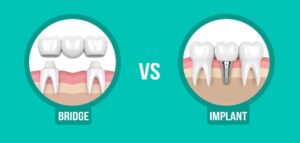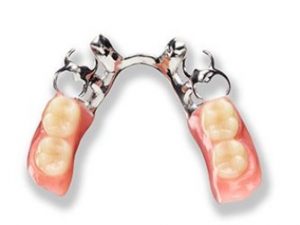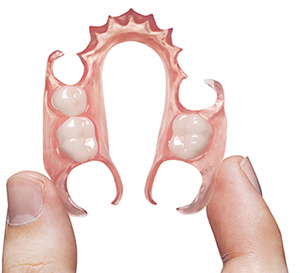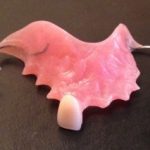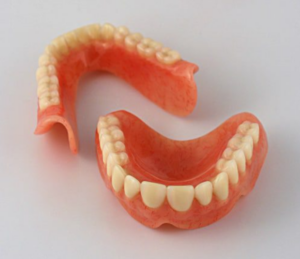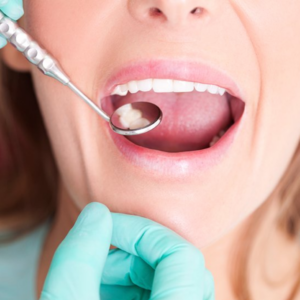
Missing a tooth and wondering what your replacement options are? This article will guide you through the top tooth replacement solutions to help restore your smile and oral function.
Key Takeaways
- Dental implants are a highly durable and reliable solution for tooth replacement, offering significant benefits such as maintaining jawbone health, preventing adjacent teeth from shifting, and providing a natural look and feel.
- Fixed bridges provide a reliable alternative to dental implants, especially suitable for patients seeking a quicker and less invasive option; however, they require periodic replacements and involve filing down healthy adjacent teeth.
- For those ineligible for fixed bridges or implants, removable partial dentures offer a cost-effective and flexible solution, albeit with limitations like the need for frequent adjustments and dietary restrictions.
Dental Implants: The Gold Standard
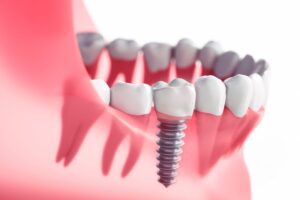
Dental implants are known for their ability to:
- Support new teeth solidly, thanks to their biocompatible and non-toxic titanium composition
- Help maintain bone growth in the jaw
- Prevent adjacent teeth from shifting
- Last a lifetime with proper care
Understanding the working mechanism and benefits of dental implants is fundamental.
How Dental Implants Work
Initiating the dental implant procedure involves:
- Substituting the tooth root with a metal screw.
- During implant surgery, an oral surgeon opens the gum, exposes the bone, and drills a hole to insert the metal post.
- This post acts as the new tooth root, providing a stable foundation for the artificial tooth.
The critical phase of osseointegration involves the jawbone integrating with the dental implant surface, thereby securing stability. This process typically requires a healing period of two to six months before the permanent restoration can be placed. The stability achieved through osseointegration is what gives dental implants their renowned durability and functionality.
The final step in the dental implant process involves:
- Creation of a crown, acting as the replacement tooth
- Attachment of the crown to a small metal post called an abutment
- Custom-making the crown to match the color and shape of your natural teeth
This completes the dental implant process and provides a seamless and natural-looking solution to missing teeth.
Benefits of Dental Implants
The multitude of advantages offered by dental implants make them a favored choice for many. One of the most significant benefits is their natural look and feel, which allows you to smile, eat, and engage in social activities without worry. Unlike fixed bridgework or dentures, dental implants don’t slip or make noise, and they can’t decay like regular teeth.
Another significant advantage of dental implants is their contribution to maintaining the health of the jawbone. Implants:
- Prevent facial sagging and premature aging by maintaining bone mass in the jaw
- Reduce bone resorption and deterioration, which helps maintain the health of the jaw
- Allow better chewing and clearer speech, closely mimicking the functionality of natural teeth.
While dental implants might incur higher upfront costs, their lasting durability renders them a cost-effective solution in the long run. With proper care and maintenance, dental implants can last a lifetime, providing a durable and reliable tooth replacement option.
Who is a Candidate for Dental Implants?
Individuals with one or several missing teeth, or those with irreparable broken or decayed teeth, are ideal candidates for dental implants. Advances in diagnostics and bone reconstruction have made dental implants viable for most patients, even those previously deemed unsuitable. Dental implants can provide a versatile solution for replacing a single tooth or multiple teeth. They are a popular option for restoring a natural-looking smile and improving oral function.
Your dentist will provide guidance considering your medical history and present oral health. A thorough consultation with a dental care professional will help determine if dental implants are the right treatment option for you. With the right care and assessment, dental implants can be an excellent choice for restoring your smile and oral health.
Fixed Bridges: Reliable and Effective
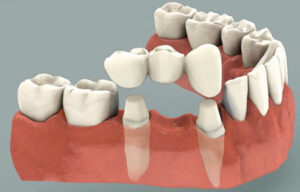
Depending on the support from surrounding teeth, a dental bridge can substitute one to four consecutive missing teeth. Custom-made to match the color and shape of your natural teeth, bridges ensure a natural look and feel. Understanding the various types of fixed bridges and their placement procedure is essential.
Types of Fixed Bridges
Several types of fixed bridges are available to consider. Traditional bridges, the most common type, consist of artificial teeth held in place by dental crowns on adjacent teeth. These crowns anchor the bridge and provide stability.
Another type is the cantilever bridge, which is supported on only one side by a dental crown on a single adjacent tooth. This type is used when there are teeth only on one side of the missing tooth or teeth.
Fixed bonded bridges, on the other hand, are held in place by abutment teeth with a framework bonded to the backs of the abutment teeth. Each type has its own set of advantages and is chosen based on the specific needs of the patient.
Procedure for Placing Fixed Bridges
Placing a dental bridge generally requires two appointments. During the first visit, the dentist will:
- Take molds of the teeth
- File down the adjacent teeth to prepare them for crowns
- Use local anesthesia to numb the gums and ensure a comfortable experience.
In the second appointment, the custom-made bridge is fitted and adjusted for comfort and functionality. This process ensures that the bridge not only restores the appearance of natural teeth but also provides a stable and functional replacement for missing teeth.
Pros and Cons of Fixed Bridges
Fixed bridges present several benefits, including:
- Preventing teeth misalignment by filling the gap created by missing teeth
- Being more comfortable than partial dentures
- Providing a natural appearance, helping to restore both function and aesthetics.
Nevertheless, there are certain disadvantages to bear in mind. Some potential disadvantages of dental bridges include:
- They require filing down healthy adjacent teeth for crown placement
- Over a lifetime, dental bridges can be more expensive due to the need for periodic replacements approximately every ten years
- While they offer a natural appearance, they connect teeth to each other, which may slightly affect aesthetics compared to implants.
Despite these cons, fixed bridges continue to be a dependable and effective choice for many seeking to replace missing teeth. Read more about implants vs bridges.
Removable Partial Dentures: Flexible Solutions
For individuals missing a few teeth, removable partial dentures offer a flexible and cost-effective solution. These dentures are suggested for those who are not suitable candidates for fixed bridges or dental implants. They offer an easy way to maintain oral hygiene and improve speaking and chewing capabilities.
Partial dentures, tailor-made for a comfortable fit in your mouth, can be effortlessly removed for cleaning. This flexibility makes them a popular choice for many people. Understanding the design and fitting process of partial dentures is crucial.
Design and Fit of Partial Dentures
Usually made from a mix of metal and acrylic, partial dentures provide strength for chewing and speaking, all while preserving a natural look. The process begins with taking impressions of your mouth to ensure a customized fit.
A plastic model of the partial denture is created and evaluated for color, shape, and fit before making the final denture. The final product is then crafted and fitted, with adjustments made as necessary over time.
Partial dentures are usually attached using metal clasps or precision attachments, ensuring stability without significant modifications to existing teeth or surgeries.
Maintenance and Care
For the longevity of partial dentures, appropriate maintenance and care are crucial. Cleaning them nightly is crucial to prevent plaque buildup and maintain oral health. Soaking partial dentures in cold water helps them retain their shape and ensures they remain comfortable to wear.
Regular dental check-ups are also important to monitor the condition of the dentures and make any necessary adjustments. Following these maintenance routines will help keep your partial dentures in good condition and ensure they continue to function effectively.
Advantages and Disadvantages
Partial dentures present multiple benefits, including:
- Enhanced speaking and eating capabilities
- Cost-effectiveness
- Help in keeping surrounding teeth from shifting into gaps left by missing teeth
- Natural appearance
- Ability to speak and eat normally
Nevertheless, there are certain limitations. Partial dentures may limit your diet, as you may need to avoid certain fruits and vegetables. They can also become looser over time, requiring adjustments or replacements. Despite these cons, partial dentures continue to be a flexible and cost-effective choice for many.
Full-Arch Dental Implants: Comprehensive Replacement
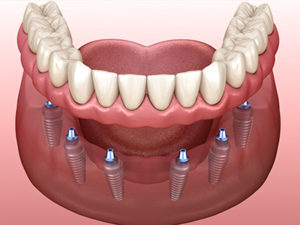
These implants are surgically anchored into the jawbone, providing exceptional stability and functionality compared to traditional dentures. Full-arch dental implants are an excellent choice for those seeking a comprehensive and durable replacement for their missing teeth.
The All-On-Four method is a popular technique used in full-arch implants.
All-On-Four Technique
The All-On-Four system involves the placement of four implants in the jawbone to support a full arch of teeth. This technique is particularly suitable for individuals who have experienced some bone loss, as the implants are placed at specific angles to maximize bone use and provide a stable solution.
One of the significant advantages of the All-On-Four technique is that it usually does not require bone grafting, even in cases of significant bone loss. This makes the procedure less invasive and allows for a quicker recovery time compared to traditional methods.
Benefits Over Traditional Dentures
Compared to traditional dentures, full-arch dental implants present several advantages. One of the most notable benefits is their superior stability. Unlike dentures that can shift or slip, full-arch implants are securely anchored in the jawbone, providing a firm foundation for chewing and speaking. This stability allows users to enjoy a wide range of foods and speak clearly without worrying about their teeth moving out of place.
Additionally, full-arch dental implants closely mimic the look and function of natural teeth, making them the closest tooth replacement option to a real tooth. This natural appearance can significantly boost confidence, allowing individuals to smile freely and engage in social activities without self-consciousness.
Treatment Timeline
The treatment process for full-arch dental implants unfolds over several stages. It begins with an initial consultation where dental goals and oral health are assessed. This consultation includes a thorough evaluation of the patient’s medical history and a discussion of the various treatment options available.
The actual procedure involves implant placement surgery, where the implants are surgically anchored into the jawbone. After the surgery, a temporary prosthesis is often provided, allowing patients to leave with a full set of teeth the same day.
The final prosthesis is placed after a healing period, completing the full-arch dental implant process.
Temporary Tooth Replacement Options
While awaiting permanent replacements, temporary tooth replacement options are crucial for preserving appearance and functionality. These solutions are particularly useful after tooth extraction or during implant placement surgeries. Various options, such as orthodontic wax, temporary dentures, and temporary crowns, can fill the void left by missing teeth.
Temporary solutions like partial dentures are essential during implant placement surgery for maintaining aesthetics. Exploring some of the most common temporary tooth replacement options is necessary.
Flippers
A flipper tooth is an acrylic removable partial denture designed to replace a few missing teeth. It can be easily inserted and removed, making it a convenient temporary solution. Flippers are commonly made of acrylic resin and are lightweight, providing a comfortable fit.
The construction of a flipper involves taking an impression of the mouth and creating the denture from dental-grade acrylic resin. Flippers are generally used as a temporary measure to fill gaps and improve aesthetics while waiting for more permanent options like implants or bridges.
Immediate Dentures
Immediate dentures are used right after tooth extraction to quickly restore appearance. These dentures are designed to be worn immediately after the teeth are removed, providing an instant solution to the gap left by the missing teeth.
However, immediate dentures typically need to be replaced after 8-12 months, once the gums and bone have healed and stabilized. This makes them a temporary solution while waiting for more permanent replacements like dental implants or fixed bridges.
Pros and Cons of Temporary Solutions
Temporary tooth replacement options present numerous benefits, including:
- Cost-effectiveness
- Rapid preparation
- Flippers, for example, look relatively natural and help stabilize existing teeth while improving chewing
- They are a practical short-term fix for those waiting for permanent solutions.
Nonetheless, these temporary solutions come with certain disadvantages. They are prone to distortion, can be uncomfortable, and often lack durability due to the use of less expensive materials. Despite these limitations, temporary replacements play a crucial role in maintaining aesthetics and function during the transition to permanent tooth replacements.
Factors to Consider When Choosing a Tooth Replacement Option

- Cost
- Treatment duration
- Aesthetic objectives
- Functional objectives
Each individual’s unique situation, budget, and overall dental health will influence the best choice for them. Personal preferences also play a crucial role in determining the most suitable tooth replacement option.
Comprehending these factors can aid in making a well-informed decision and choosing the most suitable solution for your requirements. Let’s delve into the specifics of cost comparison, treatment duration, and aesthetic and functional goals.
Cost Comparison
Various tooth replacement options are available, each carrying a different cost. Dental implants, while not the most cost-effective option, are considered a permanent solution and can last a lifetime with proper care. This makes them a valuable investment despite their higher initial cost.
On the other hand, dental bridges are generally more affordable than dental implants. The initial cost of dental bridges is significantly lower, making them a suitable choice for patients on a tight budget.
Dentures are usually the most cost-effective option among tooth replacements, offering a practical solution at a lower price point.
Treatment Duration
Patients should consider the time commitment involved in dental treatments. Dental bridges can be completed in just two appointments over a few days, providing a quick solution to missing teeth.
Treatment time for dental implants varies depending on factors such as:
- Evaluation
- Surgery
- Healing
- Placement of final restorations
This can range from immediately after tooth removal to several months or even a year after implant placement, with more complex treatments usually taking longer. Understanding the treatment duration for each option can help you plan accordingly and set realistic expectations.
Aesthetic and Functional Goals
Resembling the appearance of natural teeth, dental implants offer a seamless and aesthetically pleasing solution for missing teeth. They also restore full chewing power, allowing patients to eat normally and maintain oral hygiene through regular brushing and flossing.
Other options, like bridges and dentures, may have limitations in terms of aesthetics and functionality. While they can effectively replace missing teeth, they might not offer the same level of natural appearance and chewing efficiency as dental implants. Considering your aesthetic and functional goals is essential when choosing the right tooth replacement option.
Post-Procedure Care and Maintenance

Daily oral hygiene, professional check-ups, and special maintenance tools all play a vital role in the care of tooth replacements. Let’s explore these aspects in more detail.
Daily Oral Hygiene
Maintaining dental implants and other tooth replacements necessitates daily oral hygiene. Here are some essential practices to follow:
- Brush at least twice a day, especially before bed, to prevent bacteria from thriving overnight.
- Use a good rotary toothbrush to clean your teeth and implant restorations thoroughly.
- Floss around implant restorations daily to remove plaque and food particles.
By following these practices, you can ensure the longevity and health of your dental implants.
For those who find traditional flossing difficult, a WaterPik or oral irrigator can be effective in maintaining ideal oral hygiene. An interdental brush can also help clean hard-to-reach areas around the gums and between teeth. These daily routines are vital for keeping your tooth replacements in excellent condition.
Professional Check-Ups
To monitor the condition of dental implants and catch any potential issues early, regular dental check-ups are crucial. Implant systems require regular visits for cleaning, radiographic evaluations, and sometimes tightening or changing parts.
These professional check-ups ensure that any problems are addressed promptly, preventing more severe complications down the line. Maintaining a schedule of regular dental visits is key to the long-term success of your tooth replacements.
Special Tools for Maintenance
Employing special tools is vital for the maintenance of complex prostheses like dental implants and bridges. Regular floss may not be adequate for proper gum tissue care, and specific tools help prevent issues like debris accumulation and infection.
A Monoject™ syringe or a WaterPik® Water Flosser can be used to flush the area around an implant daily to remove debris and reduce infection risk. Additionally, electric toothbrush tips designed for implants help eliminate plaque effectively.
For cleaning bridges, a water flosser with interdental brush heads can be used after brushing and flossing to flush out areas around teeth and restorations. These tools are invaluable for maintaining the health and functionality of your tooth replacements.
Potential Risks and Complications
Although tooth replacement options are typically safe, it’s important for patients to be aware of potential risks and complications. Dental implant procedures can sometimes lead to complications like:
- Infection
- Implant failure
- Nerve damage
- Sinus problems
- Bone loss
Despite having a high success rate, dental implants can cause long-term complications.
Grasping these potential issues is vital for making a well-informed decision regarding your tooth replacement options. Let’s explore some common issues and preventive measures.
Common Issues
A common issue with dental implants is:
- the failure of osseointegration, where the bone does not grow around the implant
- implant failure or rejection may happen if the jawbone does not properly integrate with the implant
- infection at the implant site can occur due to bacteria accumulation, causing inflammation and discomfort.
Some potential complications of dental implants include:
- Gum recession around the implant, which can lead to inflammation and pain
- Improper placement of the implant, resulting in complications such as discomfort, implant loosening, or pain
- Inadequate bone density in the upper jaw, causing implants to protrude into sinus cavities and leading to sinusitis
- Rare cases of nerve damage during implant placement, resulting in numbness, pain, or tingling in the affected area
If you experience persistent pain, swelling, or signs of infection around the implant, immediate attention from a dental professional is necessary.
Preventive Measures
To prevent implant complications, it’s crucial to maintain excellent oral hygiene, which includes brushing, flossing, and using antimicrobial mouthwash. Following your dentist’s instructions for keeping incisions clean can help prevent infections after dental implant surgery.
Lifestyle changes such as quitting smoking and reducing alcohol consumption positively impact the success of dental implants. Managing medical conditions like diabetes or osteoporosis effectively can also reduce the risk of complications. Regular bite assessments at every recall appointment can prevent overloading the implant, which can lead to failure.
These preventive measures are crucial for ensuring the long-term success of dental implants and other tooth replacements.
When to Seek Help
Should you encounter any issues with your tooth replacements, it’s imperative to seek professional assistance immediately. Return to your restorative dentist if the crown or prosthesis becomes loose to avoid implant or restorative failure. Persistent pain, swelling, or fluid draining from the incision site after implant surgery should also prompt an immediate visit to your dentist.
Immediate attention from a dentist is required if the implant becomes loose or painful. Addressing these issues promptly can prevent more severe complications and ensure the longevity of your tooth replacements.
Summary
In summary, there are several tooth replacement options available, each with its own set of benefits and considerations. Dental implants offer a natural look and feel with long-term durability, while fixed bridges provide a reliable and effective solution for missing teeth. Removable partial dentures offer flexibility and affordability, and full-arch dental implants provide a comprehensive replacement for those who have lost most or all teeth in one or both dental arches.
Temporary tooth replacement options maintain appearance and function while waiting for permanent replacements. When choosing a tooth replacement option, consider factors such as cost, treatment duration, and aesthetic and functional goals. Proper post-procedure care and maintenance are crucial for the success of any tooth replacement. Understanding the potential risks and complications can help you make an informed decision and ensure the longevity of your new teeth.
Frequently Asked Questions
What are the benefits of dental implants?
Dental implants offer a natural look and feel, prevent bone resorption, and can last a lifetime with proper care, making them a beneficial option for tooth replacement.
How do fixed bridges work?
Fixed bridges work by attaching artificial teeth to neighboring natural teeth or implants to fill the gap left by missing teeth. This helps restore the functionality and appearance of the patient’s smile.
What are removable partial dentures?
Removable partial dentures are a flexible and affordable solution for individuals with a few missing teeth, as they are custom-made to fit comfortably and can be easily removed for cleaning.
What is the All-On-Four technique?
The All-On-Four technique involves placing four implants in the jawbone to support a full arch of teeth without requiring bone grafting. This technique is an effective option for those needing extensive tooth replacement.
What should I do if I experience issues with my dental implants?
You should seek immediate attention from a dental professional if you experience persistent pain, swelling, or signs of infection around the implant to prevent more severe complications.

